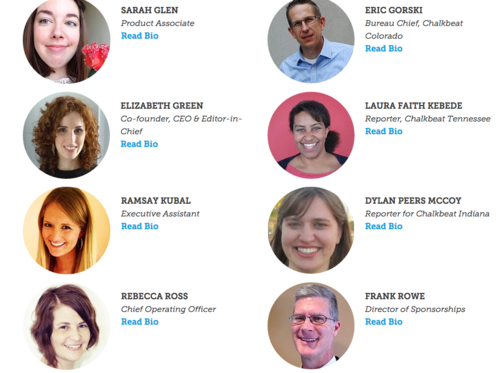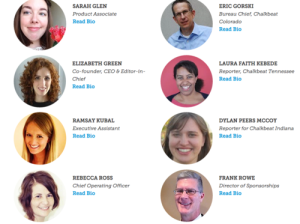
Mar 3, 2016 12:00:00 AM
 While Chalkbeat cofounder Elizabeth Green declined to give specific numbers, she emailed that “Working with people who represent the communities we cover is a strong value for us.” She added: “We are actively investing in strengthening our recruitment efforts so we can continue to build the strongest possible team.” Nobody from
The Hechinger Report responded to my emails and a text asking for information about the racial diversity of its editorial staff. A quick glance at the staff page and previous emails from Liz Willen tell us that there is at least one person of color on the editorial staff: Emmanuel Felton. (Kayleigh Skinner was on staff but doesn’t have a byline since last year. Sierra Mannie is a fellow.) As was discussed extensively on the EWA list-serv last year, a reporter doesn’t have to share the race or socioeconomic background of her story subjects in order to do a good job. And the problem may be as much of a pipeline problem (attracting and keeping minority education journalists and eliminating unpaid internships and other avenues that reward better-off candidates) as it is anything else. It’s also possible that outside funders supporting education journalism have not put much of a priority on hiring journalists of color. However, race remains an important societal issue to address and pretending it doesn’t exist has not seemed to help the situation. American schoolkids are majority-minority as of this school year, making the issue all the more important for education journalism. At last year’s EWA conference, one journalist of color noted on, “how white the education journalist community is.” You can see some posts about race and education journalism written last spring, focusing on individual journalists rather than outlets/education teams:
Bigger List Of Education Journalists Of Color (#edJOC), and
White Reporters Covering Students Of Color. This time, the question is about education-focused outlets or teams of education journalists within larger organizations. Here’s
a Poynter article about #JournalismSoWhite. You can also read back through my tweets about the issue at
#edJOC (education journalists of color).
While Chalkbeat cofounder Elizabeth Green declined to give specific numbers, she emailed that “Working with people who represent the communities we cover is a strong value for us.” She added: “We are actively investing in strengthening our recruitment efforts so we can continue to build the strongest possible team.” Nobody from
The Hechinger Report responded to my emails and a text asking for information about the racial diversity of its editorial staff. A quick glance at the staff page and previous emails from Liz Willen tell us that there is at least one person of color on the editorial staff: Emmanuel Felton. (Kayleigh Skinner was on staff but doesn’t have a byline since last year. Sierra Mannie is a fellow.) As was discussed extensively on the EWA list-serv last year, a reporter doesn’t have to share the race or socioeconomic background of her story subjects in order to do a good job. And the problem may be as much of a pipeline problem (attracting and keeping minority education journalists and eliminating unpaid internships and other avenues that reward better-off candidates) as it is anything else. It’s also possible that outside funders supporting education journalism have not put much of a priority on hiring journalists of color. However, race remains an important societal issue to address and pretending it doesn’t exist has not seemed to help the situation. American schoolkids are majority-minority as of this school year, making the issue all the more important for education journalism. At last year’s EWA conference, one journalist of color noted on, “how white the education journalist community is.” You can see some posts about race and education journalism written last spring, focusing on individual journalists rather than outlets/education teams:
Bigger List Of Education Journalists Of Color (#edJOC), and
White Reporters Covering Students Of Color. This time, the question is about education-focused outlets or teams of education journalists within larger organizations. Here’s
a Poynter article about #JournalismSoWhite. You can also read back through my tweets about the issue at
#edJOC (education journalists of color).
Alexander Russo is a freelance education writer who currently writes at his blog, The Grade and the national news site This Week In Education He has created several long-running blogs such as District 299 (about Chicago schools) and LA School Report.
The story you tell yourself about your own math ability tends to become true. This isn’t some Oprah aphorism about attracting what you want from the universe. Well, I guess it kind of is, but...
If you have a child with disabilities, you’re not alone: According to the latest data, over 7 million American schoolchildren — 14% of all students ages 3-21 — are classified as eligible for special...
The fight for educational equity has never been just about schools. The real North Star for this work is providing opportunities for each child to thrive into adulthood. This means that our advocacy...
Your donations support the voices who challenge decision makers to provide the learning opportunities all children need to thrive.
Ed Post is the flagship website platform of brightbeam, a 501(c3) network of education activists and influencers demanding a better education and a brighter future for every child.
© 2020–2024 brightbeam. All rights reserved.
Leave a Comment